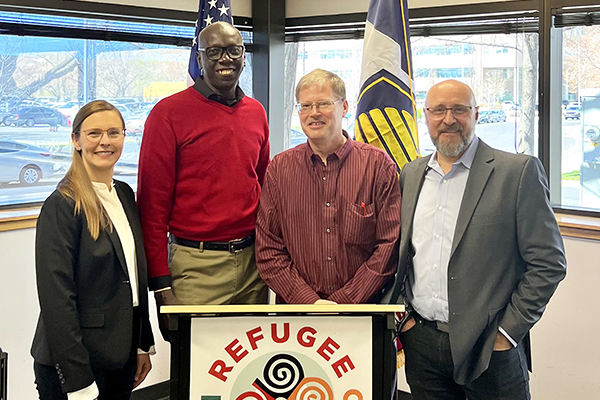USU and the U Collaborate on NSF Grant Helping Students Install Cosmic Ray Detectors on the Roof of the Utah Refugee Center

Teen refugee students work on InSPIRE project for detecting cosmic ray activity with Dr. Sarah Braden from CEHS/USU.
Students with refugee backgrounds and faculty members from the University of Utah and Utah State University recently celebrated the installation of five cosmic ray detectors in Salt Lake City. The event, hosted at the Utah Refugee Center in Salt Lake City on April 9, was the culmination of a three-year research project that began with an after-school STEM program in which refugee students and faculty constructed five cosmic ray detectors. These detectors were placed on the roof of the Utah Refugee Center building by a boom crane, where they will monitor the activity of cosmic rays.
Nearly 60 students participated in the program, entitled “Investigating the Development of STEM-Positive Identities of Refugee Teens in a Physics Out of School Time Experience (InSPIRE), which brings science research to teenagers and contributes to a worldwide effort to measure cosmic ray activity on Earth.
The students spent between one and two days every week for nearly three years building the detectors while learning the principles of particle physics and computer programming. The students designed their own research projects, posing questions such as whether the moon impacts cosmic ray detection. While some participants focused on the detectors, others focused on creating short films about their fellow students’ research journeys.
“Refugee youth often encounter many challenges related to STEM, including restricted exposure to STEM education, language barriers, cultural adjustments, and a history of interrupted schooling, resulting in a low rate of high school completion and college matriculation among refugee students,” said Tino Nyawelo, principal investigator of InSPIRE and professor of physics and astronomy at the U. “The project conducts research to better understand these challenges and how to best broaden access to and engagement in STEM for refugee youth and other historically disenfranchised populations.”
InSPIRE brings together the University of Utah, Utah State University, Utah Department of Workforce Services Refugee Services Office, as well as the Dutch National Institute for Subatomic Physics (Nikhef) in Amsterdam to involve teens in real science. Data from the students’ cosmic ray detectors helps us understand the origins of the universe. Funded by a $1.1 million grant from the U.S. National Science Foundation (NSF) in 2020, InSPIRE explores how refugee teenagers identify with STEM subjects while they participate in a cosmic ray detector-building and research project.

Dr. Sarah Braden, co-PI, USU speaks at press conference with the U on collaboration of working with teen refugee students in STEM.
“We want students with refugee backgrounds to know that they are valued in physics and in STEM disciplines more broadly,” said Sarah Braden, InSPIRE co-investigator and associate professor of cultural studies at USU’s Emma Eccles Jones College of Education and Human Services. “These students learned physics, computing skills, and filming techniques, and they brought their ingenuity, curiosity, resilience, and playfulness. Knowingly or not, the students are helping to transform the discipline in which they participate, opening new pathways for themselves and for other students to see themselves as valued contributors to STEM disciplines.”
The group’s peer-reviewed publications describe the ways in which the program supported students in engaging with their multilingualism, and the importance of encouraging teenagers’ spontaneous play in informal STEM learning environments. As one participant shared, “I didn’t know I was interested in STEM. But when we did the building and the soldering and the calibrating, I learned I have a passion for science. And I’m more confident now in science-related topics, especially when the activities are more than sitting and learning.”
The detector technology is adapted from HiSPARC (High School Project on Astrophysics Research with Cosmics), a collaboration that started in the Netherlands aimed at improving high schoolers’ interest in physics. There are now more than 140 student-built detectors on buildings in the Netherlands, Namibia, and the United Kingdom that upload data 24/7 to publicly available databases.

Tino Nywelo, PI, the U; Sarah Braden, co-PI, USU; Jordan Gerton, co-PI, the U; and John Matthews, co-PI, the U gather to celebrate culmination of NSF grant with teen refugee students in STEM.
“This important work would not have been possible without the collaboration between the University of Utah and Utah State University,” said Jordan Gerton, InSPIRE co-principal investigator and professor of physics and astronomy at the U. “Sarah’s team at USU led pioneering research that sheds light on how students from historically marginalized groups develop a sense of belonging in STEM. Equally important, their expertise enabled the students to experience an environment supportive of their individual cultures, languages, and varied experiences. This project leveraged the strengths of both institutions and has built the foundation for continued work with K-12 students and, critically, teachers.”
Students all over Utah will soon be able to participate. The U.S. NSF recently awarded the InSPIRE team $1 million to fund Research Experiences for Undergraduates (REU) and Research Experiences for Teachers (RET) in Utah. RET seeks to integrate high school education with professional scientific research in experimental cosmic-ray physics by training local teachers. For more information, visit HISPARC.

